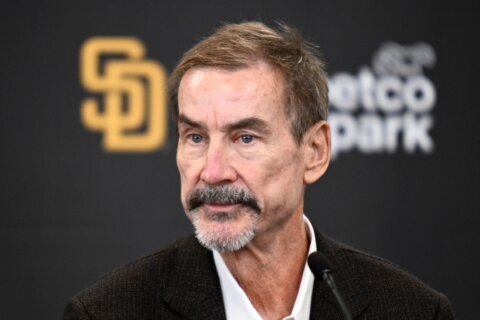WASHINGTON — In many ways, it’s every fan’s dream. Who wouldn’t want the chance to speak, face-to-face, with the big boss, the guy in charge of your favorite sports team?
Surely you’d have suggestions, born out of years of experience at the ballpark and following the game from home. Maybe you’d have complaints, maybe just simple requests that you never actually expected anyone to listen to. But when would the average fan actually be able to gather such an audience?
If you’re a fan of the Oakland Athletics, every Tuesday between 3 -5 p.m.
Yes, really.
Team President Dave Kaval is hosting open office hours, available by appointment to any fan who has something to tell him. As personal connection between top level professional sports clubs and their fans gets seemingly more distant each year, the A’s are taking a radical turn in the other direction — if not an entirely novel one. Kaval did the same thing at his last stop, as head of the San Jose Earthquakes.
“It all started back when I started teaching at Stanford, at the business school, and I would have office hours as a professor,” Kaval told WTOP last week as the Athletics prepared for Opening Day. “It made me think, maybe I should have office hours for the other job I’m doing.”
One could forgive a complete rejection of such a concept from a high-ranking pro sports team official. But Kaval saw something working in San Jose. Also, while he may be a Cleveland, Ohio native, his wife grew up an A’s fan in the East Bay, giving him direct insight into the fan base’s passion. And with the Golden State Warriors and Oakland Raiders each committing to leave the East Bay in the next few years — for San Francisco and Las Vegas, respectively — he saw an opportunity to step into the void and strengthen the connection with the city’s soon-to-be lone remaining professional team.
“People have just absolutely been enthralled with the concept and it’s resonated with the community,” he said. “And it’s been a tremendous way for me to connect to our fan base, and learn about what they care about and the direction this club needs to take.”
***
Plenty of organizations pay lip service to the idea of customer service. But how important is it, really?
A 2009 study found that, among both sports fans and non-sports fans, a majority of people say quality service can make the ultimate difference in what they buy. More recently, a 2016 J.D. Power report found the range of fans that strongly agree that the organization cares about them swings from 28 to 54 percent. Even on the high-end, that isn’t spectacular, but it’s especially troubling on the low end.
If the way people are taken care of impacts their purchasing decisions, how will they respond to sports teams that they often don’t believe care about them?
Greg Truex is the senior director of U.S. service industries at J.D. Power. Truex and his team have identified key performance indicators, which are relative to behaviors that drive overall satisfaction. When it comes to index performance measures, the price paid for a ticket was actually just the 22nd ranked of 35 attributes. The most important to satisfaction was that the staff left you with a good, lasting impression.
Furthermore, when nine or 10 of the top 10 measures were met, there was nearly a 100 percent increase in yearly dollars spent at team games over the amount spent when just one or two of these measures were met. But that level of satisfaction has hardly been consistent, according to research.
“That is only happening 48 percent of the time across professional sports,” said Truex.
The growing lack of personal touch between large professional sports organizations and their fans certainly isn’t helping that number. Kaval recognizes the challenge as one born out of the evolving media and financial landscape.
“I think it’s a big issue that the biggest leagues are facing,” he said. “Because there’s the escalation in media contracts. So what happens is their number one revenue stream is television, or digital or media as opposed to tickets. And that’s a big change, and so that means you focus on different things.”
But focusing on the fan remains vital to long-term success.
“Any increased engagement from anyone within the organization (is important),” said Truex. “And our recommendation is that it’s got to extend beyond season ticket holders and suite owners.”
Likewise, the higher up the executive within the organization, the more significant the impact. While it’s crucial to have ushers and ticket sellers with friendly dispositions, a conversation with a vice president level executive or above has a much stronger result.
So, say, a conversation with a team president?
“It does increase engagement,” said Truex. “And therefore it does correlate very well with overall satisfaction, advocacy and then even loyalty.”
***
A winning team and a sparkling, new ballpark can buy a lot of goodwill for a front office. The A’s had neither of these luxuries entering 2017. The club is coming off back-to-back sub-70 win campaigns for the first time since the mid-90s, and the search for a new stadium has been a seemingly never-ending, unfunny comedy of stops and starts, with threats of relocation both near and far bandied about.
Kaval and the team have already committed to an announcement of a new stadium — in Oakland — this calendar year. But until that new ballpark is announced, financed, constructed and opened, the Coliseum remains home. That provides both the more immediate challenge and opportunity to improve the gameday experience today, something very much on the minds of fans in their office hour meetings with Kaval thus far.
“I think it kind of splits three ways,” Kaval said. “I think it’s about a third where the ballpark needs to go and what it needs to be like, a third around the team performance and retaining our young players and not letting them go. And I think the last third is really around the Coliseum, and what can we do to make sure that the current experience is the best it can be.”
One suggestion was to incorporate food trucks into the gameday experience; they now dot the revitalized Champions Pavillion between the Coliseum and Oracle Arena, where the Warriors play. There was the idea to name the field after a former player; the Rickey Henderson Field dedication was Monday. One fan pleaded for the team to move FanFest to Jack London Square in Downtown Oakland; the staff made it happen on just a few weeks’ notice.
“A lot (of) things help reinforce and help give me a stronger conviction about decisions maybe I was going to make, or maybe I wasn’t fully aware of,” Kaval said.
Other things have also come up, the kinds of suggestions most fans wouldn’t even think about, that the organization has acted on.
One disabled fan said he was afraid to use parts of the stadium that didn’t have rails, as the Coliseum was constructed before ADA laws that required them. The lower bowl was fitted with new railings for Opening Day, with the rest of the park set to be complete within a couple weeks.
A parent complained that the Kids Zone didn’t appeal to children above toddler age. New features were added to make it more all-encompassing.
“These may seem like small things, but they’re real,” said Kaval. “And there’s tons of these like this.”
The A’s may have their eyes set on their future home, but the team has already spent $4 million in improvements at the Coliseum this year, and Kaval expects them to spend more before the season is done.
The long-term dream for front office and fans alike is a new ballpark at home in Oakland. Kaval says the goal is to take the notoriously low-spending team into the top quartile in spending and to get back to winning championships, as they did in the 70s and 80s. But all those are talking points. For now, there is greater value in listening.
“Sometimes people get a little heated about it,” Kaval said. “But overall I’ve always found that people have a positive intent and are just trying to work together with me to make sure this organization is stronger.”







